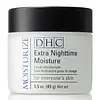What's inside
What's inside
 Key Ingredients
Key Ingredients

 Benefits
Benefits

 Concerns
Concerns

 Ingredients Side-by-side
Ingredients Side-by-side

Centella Asiatica Leaf Water
Skin ConditioningButylene Glycol
HumectantGlycerin
HumectantHelianthus Annuus Seed Oil
EmollientCaprylic/Capric Triglyceride
MaskingCetearyl Alcohol
EmollientBetaine
Humectant1,2-Hexanediol
Skin ConditioningCetearyl Olivate
Elaeis Guineensis Oil
EmollientCeramide NP
Skin ConditioningSorbitan Olivate
EmulsifyingHydrogenated Lecithin
EmulsifyingTriethylhexanoin
MaskingBeeswax
Emulsion StabilisingElaeis Guineensis Kernel Oil
EmollientHydroxyethyl Acrylate/Sodium Acryloyldimethyl Taurate Copolymer
Emulsion StabilisingEthylhexylglycerin
Skin ConditioningCyclohexasiloxane
EmollientCassia Obtusifolia Seed Extract
Skin ConditioningSucrose Distearate
EmollientDipropylene Glycol
HumectantPanthenol
Skin ConditioningNiacinamide
SmoothingDimethicone/Vinyl Dimethicone Crosspolymer
Skin ConditioningGlyceryl Stearate
EmollientXanthan Gum
EmulsifyingSodium Hyaluronate
HumectantLimonene
PerfumingCitrus Aurantium Bergamia Fruit Oil
MaskingAsiaticoside
AntioxidantAsiatic Acid
Skin ConditioningMadecassic Acid
Skin ConditioningLinalool
PerfumingCentella Asiatica Leaf Water, Butylene Glycol, Glycerin, Helianthus Annuus Seed Oil, Caprylic/Capric Triglyceride, Cetearyl Alcohol, Betaine, 1,2-Hexanediol, Cetearyl Olivate, Elaeis Guineensis Oil, Ceramide NP, Sorbitan Olivate, Hydrogenated Lecithin, Triethylhexanoin, Beeswax, Elaeis Guineensis Kernel Oil, Hydroxyethyl Acrylate/Sodium Acryloyldimethyl Taurate Copolymer, Ethylhexylglycerin, Cyclohexasiloxane, Cassia Obtusifolia Seed Extract, Sucrose Distearate, Dipropylene Glycol, Panthenol, Niacinamide, Dimethicone/Vinyl Dimethicone Crosspolymer, Glyceryl Stearate, Xanthan Gum, Sodium Hyaluronate, Limonene, Citrus Aurantium Bergamia Fruit Oil, Asiaticoside, Asiatic Acid, Madecassic Acid, Linalool
Water
Skin ConditioningButylene Glycol
HumectantCetyl Ethylhexanoate
EmollientTriethylhexanoin
MaskingGlycerin
HumectantHydrogenated Palm Oil
EmollientOlea Europaea Fruit Oil
MaskingSqualane
EmollientGlyceryl Stearate Se
EmulsifyingStearic Acid
CleansingBehenyl Alcohol
EmollientPentylene Glycol
Skin ConditioningPolysorbate 60
EmulsifyingLeuconostoc/Radish Root Ferment Filtrate
AntimicrobialIsostearic Acid
CleansingPhenoxyethanol
PreservativeCarbomer
Emulsion StabilisingSerine
MaskingDipotassium Glycyrrhizate
HumectantPotassium Hydroxide
BufferingTocopherol
AntioxidantSodium Hyaluronate
HumectantIsostearoyl Hydrolyzed Collagen
CleansingWater, Butylene Glycol, Cetyl Ethylhexanoate, Triethylhexanoin, Glycerin, Hydrogenated Palm Oil, Olea Europaea Fruit Oil, Squalane, Glyceryl Stearate Se, Stearic Acid, Behenyl Alcohol, Pentylene Glycol, Polysorbate 60, Leuconostoc/Radish Root Ferment Filtrate, Isostearic Acid, Phenoxyethanol, Carbomer, Serine, Dipotassium Glycyrrhizate, Potassium Hydroxide, Tocopherol, Sodium Hyaluronate, Isostearoyl Hydrolyzed Collagen
 Reviews
Reviews

Ingredients Explained
These ingredients are found in both products.
Ingredients higher up in an ingredient list are typically present in a larger amount.
Butylene Glycol (or BG) is used within cosmetic products for a few different reasons:
Overall, Butylene Glycol is a safe and well-rounded ingredient that works well with other ingredients.
Though this ingredient works well with most skin types, some people with sensitive skin may experience a reaction such as allergic rashes, closed comedones, or itchiness.
Learn more about Butylene GlycolGlycerin is already naturally found in your skin. It helps moisturize and protect your skin.
A study from 2016 found glycerin to be more effective as a humectant than AHAs and hyaluronic acid.
As a humectant, it helps the skin stay hydrated by pulling moisture to your skin. The low molecular weight of glycerin allows it to pull moisture into the deeper layers of your skin.
Hydrated skin improves your skin barrier; Your skin barrier helps protect against irritants and bacteria.
Glycerin has also been found to have antimicrobial and antiviral properties. Due to these properties, glycerin is often used in wound and burn treatments.
In cosmetics, glycerin is usually derived from plants such as soybean or palm. However, it can also be sourced from animals, such as tallow or animal fat.
This ingredient is organic, colorless, odorless, and non-toxic.
Glycerin is the name for this ingredient in American English. British English uses Glycerol/Glycerine.
Learn more about GlycerinSodium Hyaluronate is hyaluronic acid's salt form. It is commonly derived from the sodium salt of hyaluronic acid.
Like hyaluronic acid, it is great at holding water and acts as a humectant. This makes it a great skin hydrating ingredient.
Sodium Hyaluronate is naturally occurring in our bodies and is mostly found in eye fluid and joints.
These are some other common types of Hyaluronic Acid:
Learn more about Sodium HyaluronateTriethylhexanoin is created from glycerin and 2-ethylhexanoic acid. It is a solvent and emollient.
As a solvent, Triethylhexanoin helps dissolve ingredients to stable bases or help evenly distribute ingredients throughout the product.
It is also an emollient and helps condition the skin.
Learn more about Triethylhexanoin